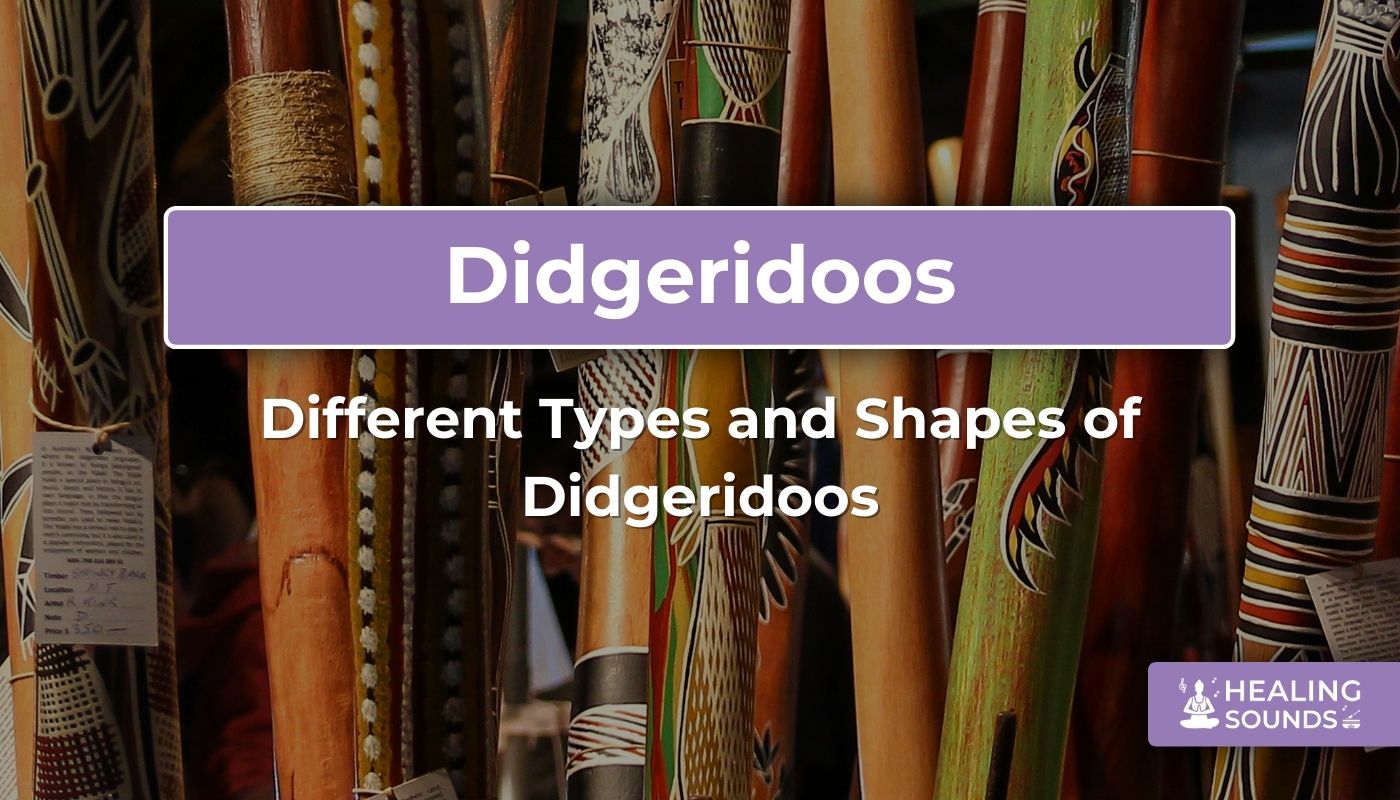Die australischen Aborigines bauen und spielen Didgeridoos seit Jahrtausenden, möglicherweise sogar seit über 1.500 Jahren. Dieses uralte Blasinstrument, das hauptsächlich aus Arnhem Land im Northern Territory stammt, fasziniert mit seinem einzigartigen dröhnenden Klang und seiner tiefen kulturellen Resonanz ein weltweites Publikum. Aber wussten Sie, dass es nicht nur eine Art gibt? Um dieses faszinierende Instrument voll und ganz schätzen zu können, ist es wichtig, die verschiedenen Didgeridoo-Typen und -Formen zu verstehen. In diesem Leitfaden erkunden wir die Welt der Didgeridoo-Varianten , ihre unterschiedlichen Merkmale und wie die Form Funktion und Klang beeinflusst.
Was ist ein Didgeridoo? Ein Blick auf seine Ursprünge
Das Didgeridoo ist im Grunde ein traditionelles Blasinstrument und gilt als eines der ältesten überhaupt. Sein unverwechselbarer Klang entsteht durch die Vibration der Lippen im Mundstück und die Anwendung einer speziellen Technik namens Zirkularatmung, die einen kontinuierlichen Ton erzeugt. Neben seinen musikalischen Qualitäten hat das Didgeridoo für viele Aborigine-Gruppen eine tiefe kulturelle und spirituelle Bedeutung und wird oft in Zeremonien und Geschichten verwendet.
Traditionelle Didgeridoos: Die Eukalyptuswurzel
Die bekanntesten und traditionellsten Didgeridoos stammen aus Nordaustralien. Einheimische Handwerker fertigen diese Instrumente typischerweise aus bestimmten Eukalyptusarten, die von Termiten (Larven holzbohrender Motten) auf natürliche Weise ausgehöhlt werden. Dieser natürliche Prozess führt dazu, dass jedes traditionelle Eukalyptus-Didgeridoo in seiner inneren Form und seinen Abmessungen einzigartig ist.
Die Rolle der Termite bei der Klangerzeugung
Termiten höhlen die Eukalyptusstämme gezielt aus und erzeugen dadurch Unregelmäßigkeiten und Variationen im Bohrloch. Dieser natürliche Aushöhlungsprozess ist entscheidend und trägt maßgeblich zu den reichen, komplexen Obertönen und der einzigartigen Klangfarbe bei, die für authentische, traditionelle Instrumente charakteristisch sind. Die resultierende Form ist oft leicht konisch.
Wie Länge und Durchmesser den Klang prägen
Die physikalischen Abmessungen beeinflussen die Tonhöhe und Resonanz eines Didgeridoos stark:
- Länge: Längere Instrumente erzeugen im Allgemeinen niedrigere, tiefere Töne (Tonarten wie A, B, C), während kürzere Instrumente höhere Töne erzeugen (Tonarten wie E, F, G).
- Innendurchmesser (Bohrung): Eine größere Bohrung erzeugt tendenziell einen lauteren, resonanteren Klang bei geringerem Gegendruck, was Anfängern das Spielen manchmal erleichtert. Eine kleinere Bohrung erzeugt oft einen höheren Gegendruck, was fortgeschrittene Techniken wie Vokalisationen und Obertöne erleichtern kann und zu einem klareren, fokussierteren Klang führt.
- Glockenform: Die Endverbreiterung oder Glocke kann den Klang verstärken und die Klarheit des Borduns und der Obertöne beeinflussen.
Yidaki vs. Didgeridoo: Die Begriffe verstehen
Obwohl „Didgeridoo“ der allgemein bekannte Name ist, handelt es sich dabei um ein lautmalerisches Wort, das möglicherweise von Westlern geprägt wurde. Die Aborigines haben je nach Region und Sprachgruppe viele traditionelle Namen für das Instrument. Yidaki (manchmal auch Yirdaki geschrieben) ist die spezifische Bezeichnung der Yolngu im Nordosten von Arnhem Land für ihre traditionelle Form des Instruments, die besondere Spieleigenschaften und einen besonderen kulturellen Kontext aufweist. Ein Yidaki ist also eine bestimmte Art von traditionellem Didgeridoo, aber nicht alle Didgeridoos sind Yidaki.
Verschiedene Didgeridoo-Formen entdecken
Während traditionelle Eukalyptusinstrumente oft leicht konisch sind, hat die moderne Handwerkskunst verschiedene andere Formen eingeführt, die sowohl den Klang als auch die Tragbarkeit beeinflussen.
Konische Didgeridoos: Der klassische Kegel
Viele traditionelle und moderne Didgeridoos haben eine konische Form, d. h. sie weiten sich vom Mundstückende zum Schalltrichterende hin allmählich auf. Diese Verjüngung führt oft zu einem helleren Klang mit ausgeprägteren Obertönen im Vergleich zu zylindrischen Formen ähnlicher Länge und Tonhöhe.
Zylindrische Didgeridoos: Gleichbleibender Durchmesser
Zylindrische Didgeridoos haben über ihre gesamte Länge einen relativ konstanten Durchmesser. Diese Form kann im Vergleich zu konischen Instrumenten einen tieferen, grundtonlastigeren Dröhnklang mit potenziell weniger komplexen Obertönen erzeugen. Sie bieten oft weniger Gegendruck, was für manche Anfänger leichter zu handhaben ist.

Didgeridoo, australisches Teakholzinstrument
$149.90 $209.90
Entdecken Sie die einzigartige Resonanz von Teakholz mit diesem langlebigen zylindrischen Didgeridoo, ideal für Anfänger, die verschiedene Didgeridoo-Typen erkunden möchten.
Entdecken Sie Teak DidgeridooEinzigartige und moderne Formen: Innovation trifft Tradition
Durch Innovationen sind faszinierende Variationen der traditionellen Form entstanden:
- Spiral-Didgeridoos: Bei diesen kompakten Instrumenten wölbt sich die Röhre in eine Spiralform, wodurch sie sehr tragbar sind und gleichzeitig den tiefen Klang behalten, der für längere Instrumente charakteristisch ist.
- Box-Didgeridoos: Ähnlich wie Spiralen führen diese die Atemwege in einer kompakten Boxform, um sie tragbar zu machen.
- Didjeribone: Dies sind Schiebedidgeridoos, oft aus Kunststoff, mit zwei Röhren, die gegeneinander gleiten, wodurch der Spieler die Tonhöhe wie bei einer Posaune verändern kann. Dies unterscheidet sich erheblich von einem traditionellen Didgeridoo mit fester Tonhöhe.
- Glockenformen: Übertriebene Glockenenden können die Klangprojektion weiter verstärken.
Diese modernen Didgeridoo-Formen bieten praktische Lösungen für unterwegs und einzigartige Klangmöglichkeiten.
Mehr als Eukalyptus: Materialien für Didgeridoos
Während von Termiten ausgehöhlter Eukalyptus das traditionelle Material ist, werden heute verschiedene Hölzer und synthetische Materialien verwendet, die sich jeweils auf Klang, Haltbarkeit und Kosten auswirken.
Traditionelle Hölzer
Neben Eukalyptus werden traditionell manchmal auch andere australische Harthölzer wie Bloodwood und Mallee verwendet, die für ihre Dichte und Resonanz bekannt sind.
Moderne Materialien
Moderne Hersteller nutzen eine größere Auswahl an Materialien:
| Material | Klangeigenschaften | Haltbarkeit | Hinweise |
|---|---|---|---|
| Eukalyptus (traditionell) | Reichhaltig, komplex, resonant, einzigartig | Mäßig (anfällig für Risse bei mangelnder Pflege) | Die authentische, traditionelle Wahl. |
| Teak | Warm, resonant, langlebig | Hoch | Eine beliebte Alternative zu Hartholz. |
| Mahagoni | Warme Töne, gutes Sustain | Hoch | Wird häufig für tragbare Designs verwendet. |
| Bambus | Heller, heller Ton, leicht | Mäßig (kann sich teilen) | Erschwinglich, wird oft für Anfänger- oder Reisedidges verwendet. |
| PVC/Kunststoff | Konsistenter, klarer Ton, manchmal weniger komplex | Sehr hoch (witterungsbeständig) | Ideal zum Üben, Reisen und für Didjeribones. |
| Fiberglas/Kohlefaser | Hell, laut, extrem langlebig | Sehr hoch | Moderne Materialien für Leistung und Reisen. |
Die Materialwahl beeinflusst maßgeblich die Klangfarbe und Belastbarkeit des Instruments. Berücksichtigen Sie bei der Auswahl, wo und wie Sie spielen werden.
Entdecken Sie vielfältige Didgeridoo-Optionen

179,90 €
249,90 €
Entdecken Sie resonante, heilende Töne mit diesem wunderschön gefertigten Instrument in klassischer Didgeridoo-Form , ideal für die Meditation. Mehr erfahren ➔

149,90 €
209,90 €
Erleben Sie, wie innovative Didgeridoo-Formen wie dieses Spiraldesign tiefen Klang und außergewöhnliche Mobilität für Therapie oder Reisen bieten. Mehr erfahren ➔

179,90 €
249,90 €
Dieses tragbare Modell aus edlem Mahagoni bietet Langlebigkeit und warme Töne und demonstriert die Vielseitigkeit der Didgeridoo-Typen . Mehr erfahren ➔
Die Wahl Ihres Didgeridoos: Zu berücksichtigende Faktoren
Wie findet man bei der großen Auswahl an Didgeridoos das richtige? Beachten Sie folgende Faktoren:
- Klangpräferenz: Bevorzugen Sie tiefe, resonante Dröhntöne oder hellere Töne mit komplexen Obertönen? Hören Sie sich nach Möglichkeit Klangbeispiele an.
- Verwendungszweck: Möchten Sie es für Auftritte, Meditation, Klangheilung oder zum Lernen verwenden? Ein resonanter Eukalyptus eignet sich möglicherweise hervorragend zur Heilung, während ein langlebiges PVC oder eine Spirale für Reisen geeignet sein könnte.
- Tragbarkeit: Wenn Sie häufig reisen, sind kompakte Formen wie Spiral- oder Kastendidgeridoos oder langlebige Materialien wie PVC oder Mahagoni möglicherweise ideal.
- Schwierigkeitsgrad: Manche finden Instrumente mit geringerem Gegendruck (oftmals größere Bohrungen oder Kunststoffe) einfacher für den Anfang. Es ist jedoch auch sehr lohnend, mit einem hochwertigen traditionellen Instrument zu beginnen.
- Budget: Die Preise reichen von erschwinglichen synthetischen Modellen bis hin zu hochpreisigen traditionellen Instrumenten in Kunstqualität.
Letztendlich ist das beste Didgeridoo dasjenige, das zu Ihnen persönlich passt und Ihren Bedürfnissen entspricht.
- Hören Sie sich verschiedene Tonarten und Materialien an.
- Berücksichtigen Sie den Gegendruck – wie viel Widerstand Sie beim Blasen spüren.
- Berücksichtigen Sie Gewicht und Größe für Handhabung und Transport.
- Denken Sie an die Haltbarkeitsanforderungen je nach Verwendung.
Ein Hinweis zum kulturellen Respekt
Das Didgeridoo ist tief mit der Kultur und Spiritualität bestimmter australischer Ureinwohnergruppen verwoben. Es ist wichtig, dem Instrument mit Respekt für seine Ursprünge zu begegnen. Obwohl die Traditionen rund um das Instrument, einschließlich der Spieler, zwischen den verschiedenen Aborigine-Nationen und -Gemeinschaften stark variieren können, ist es für alle Spieler und Liebhaber von größter Bedeutung, seinen heiligen Status und seine kulturelle Bedeutung anzuerkennen. Die Auseinandersetzung mit seiner Geschichte aus indigenen Quellen, wie dem National Museum of Australia , steigert die Wertschätzung.
Andere Namen für das Didgeridoo
Aufgrund seiner vielfältigen Ursprünge im australischen Aborigine-Gebiet hat das Instrument viele Namen. Neben dem weithin bekannten „Didgeridoo“ und der spezifischen Bezeichnung „Yidaki“ gibt es je nach Sprachgruppe und Region auch andere Namen wie Mago (West-Arnhemland), Djalu (spezifischer Yolngu-Begriff), Mandapul und viele andere. Die Verwendung traditioneller Namen, wo angebracht, zeugt von größerem Respekt und Verständnis.
Fazit: Finden Sie Ihren Sound
Vom Termiten-Eukalyptus-Yidaki aus Arnhemland bis hin zu modernen Spiral- und synthetischen Varianten – die Welt des Didgeridoos ist reich und vielfältig. Das Verständnis der verschiedenen Didgeridoo-Typen und der Wirkung unterschiedlicher Formen und Materialien hilft Ihnen, die Nuancen des Instruments zu schätzen. Ob Sie die komplexen Obertöne eines traditionellen Instruments zur Klangheilung, eine langlebige Option zum Lernen oder ein tragbares Design für unterwegs suchen – es gibt ein Didgeridoo, das Sie mit seinem uralten, erdenden Klang verbindet. Entdecken Sie die Kollektion von Healing Sounds und finden Sie das Instrument, das zu Ihnen passt.
Häufig gestellte Fragen zu Didgeridoo-Typen und -Formen
Ja, es gibt viele Arten von Didgeridoos . Traditionell werden sie von australischen Aborigines aus von Termiten ausgehöhltem Eukalyptusholz hergestellt. Moderne Varianten umfassen Instrumente aus verschiedenen Hölzern (wie Teak, Bambus, Mahagoni), synthetischen Materialien (PVC, Fiberglas) und innovativen Formen (wie Spiral- oder Kastendidgeridoos für den Transport) sowie Slide-Didgeridoos (Didjeribones).
Das Didgeridoo hat eine tiefe kulturelle Bedeutung. Die Traditionen bezüglich seiner Verwendung, einschließlich der Frage, wer es spielen oder berühren darf, unterscheiden sich stark zwischen den verschiedenen australischen Ureinwohnernationen und -gemeinschaften. In einigen Traditionen wird es hauptsächlich von Männern in zeremoniellen Kontexten gespielt. Die Ansichten gehen jedoch auseinander, und auch heute noch spielen viele Aborigine-Frauen das Instrument. Es ist wichtig, dem Didgeridoo mit Respekt für seine kulturellen Ursprünge zu begegnen und die unterschiedlichen Protokolle zu beachten.
„Didgeridoo“ ist ein allgemeiner, nicht-aboriginesischer Begriff. Yidaki ist die spezifische Bezeichnung des Yolngu-Volkes im Nordosten von Arnhemland für sein traditionelles Instrument, das besondere Merkmale (oft länger, konischer, weniger Gegendruck) und kulturelle Bedeutung aufweist. Ein Yidaki ist also eine kulturspezifische Art des traditionellen Didgeridoos , der Begriff Didgeridoo umfasst jedoch viele weitere Variationen.
Das Instrument hat in den verschiedenen Sprachen der australischen Aborigines zahlreiche Namen. Neben dem gebräuchlichen Begriff „Didgeridoo“ gibt es traditionelle Namen wie Yidaki (Yolngu), Mago (West Arnhem Land), Kenbi, Mandapul und Djalu. Die Verwendung des korrekten regionalen Namens zeugt von kulturellem Bewusstsein.
Ein traditionelles Didgeridoo hat typischerweise eine feste Länge und Tonhöhe, die durch seine natürliche Bauweise bestimmt wird. Ein Didgeridoo hingegen ist eine moderne Erfindung, meist aus Kunststoff gefertigt und mit zwei verschiebbaren Rohren ausgestattet. Diese Konstruktion ermöglicht es dem Spieler, die Länge des Instruments und damit die Tonhöhe während des Spielens zu verändern, ähnlich wie bei einer Posaune, was bei einem traditionellen Didgeridoo nicht möglich ist.

